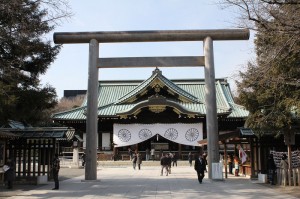Yasukuni Shrine (1) 2015/02/16
Yasukuni Shrine is internationally most famous among around 100,000 shrines in Japan. It is mainly because Yasukuni has become political issue since 1985.
The origin of Yasukuni Shrine is Shokonsha established at Kudan in Tokyo in the second year of the Meiji era (1869), and in 1879, it was renamed as Yasukuni Shrine. The name “Yasukuni,” given by the Emperor Meiji represents wishes for preserving peace of the nation.
The Shrine was established for the purpose of relieving the souls of men who sacrificed themselves and contributed to found the modern Japan through Meiji Reform. Since then, the Shrine has enshrined people who made ultimate sacrifice for their nation during national crisis such as the Boshin War, the Seinan War, the Sino-Japanese and Russo-Japanese wars, World War I, the Manchurian Incident, the China Incident and the Greater East Asian War (World War II). Consequently more than 2,466,000 people are enshrined at Yasukuni Shrine as of today and all these people, regardless of their rank or social standing, are considered to be completely equal and worshipped as venerable divinities of Yasukuni.
Most of these people died in wars as above mentioned and Yasukuni Shrine always remind us of those wars. Therefore there are some people who speak ill of Yasukuni Shrine as the symbol of wars or militarism and against visiting the Shrine by imperial families or officials such as prime minister.
Even after World War II, Emperor and officials frequently visited the Shrine to respect those who died in wars without any dispute, however in 1985, with the support of Japanese left wing media, China suddenly opened criticism against visiting the Shrine by important persons, claiming such visits lead to beautify or justify the war. Since then, visiting Yasukuni Shrine has become not a small political issue.
However it is common around the world to respect people who sacrificed themselves to their nation and also to have official commemorative rituals attended by royal families or government leading officials. It also should be completely domestic matter to visit shrines in accordance with nation’s traditional customs.
Indeed, it has been long customs in Japan to respect the deceased whoever he was and to respect more deeply and especially the deceased who died for the community or the group. This customs or belief has nothing to do with militarism.








